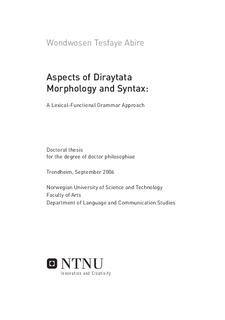| dc.description.abstract | This thesis examines Aspects of Diraytata Morphology and Syntax as it relates to lexical categories, predicate arguments, anaphoric binding relations and patterns of argument structure and mapping relations in light of the theory of Lexical-Functional Grammar. Diraytata is one of leastknown languages in the Konsoid chain in the Oromoid subgroup in the Nuclear Southern Lowland East Cushitic group within the Cushitic family. The Ethiopian Languages Research Center (ELRC), of which the candidate is a member, gives priority and encourages its staff to conduct research on the least studied languages. The present thesis goes in line with the research priority of the Center. The data were obtained from informants from two longer fieldtrips to Dirashe Special District. The methods used for data collection were elicitation and group discussion.
The thesis has two parts and ten chapters. The first chapter gives a general introduction to the people, the language, previous studies on the language, etc. and the second chapter introduces the theoretical framework.
Part I, from chapters 3 to 5, examines the morphology of Diraytata. In chapter 3, the noun morphology has been presented. In Diraytata case and definiteness are inextricably bound up with the focus system and hence inexplicable without a prior exposure to the focus system. The major claim is that the nominative case is inappropriate to designate a subject case in Diraytata and be replaced by non-focalized subject case (NFS).
In chapter 4, the adjectives have been considered. Attributive adjectives inflect for gender and number. The predicative adjectives occur in clause final position. It has been argued that the attributive and predicative adjectives in Diraytata are derived from a common categorially unspecified bound stem.
In chapter 5, the verb morphology has been discussed. In the first section, we have dealt with inflections. We said that verbs inflect for various grammatical categories such as for agreement, aspect and mood. We posited a phonetically null bound affix "ø" in order to fill the gap in a predicate paradigm. The newly introduced null bound affix "ø" has a third person masculine singular interpretation. In the second section, we have seen the verb derivations: passives, middles and causatives.
Part II, from chapters 6 to 9, discusses the syntax. In chapter 6, the phrasal arguments of Diraytata have been examined. We have classified the predicates into three types on the basis of the types of arguments they select at f-structure.
In chapter 7, the clausal complements have been considered. The clausal complements are classified into two: controlled and non-controlled. The latter type does not allow an external controller to control clause internal arguments whereas the former type allows an external controller to control clause internal argument.
In chapter 8, the anaphoric binding relation has been discussed. We have divided the anaphors of Diraytata into two: nuclear and non-nuclear anaphors. The nuclear anaphors subsume reflexives and reciprocals. There are two types of reflexive morphemes: ?iss and mašš-. Reciprocity is indicated by the morpheme ?orr. The reflexive and the reciprocal function as an object argument only. On the other hand, the non-nuclear anaphors subsume pronouns designated by PRO.
In chapter 9, the argument structure and the Lexical Mapping Theory have been discussed. We have considered the application of LMT to various predicates in Diraytata such as intransitive, transitive, passive, raising and causative predicates. The major claim is that the standard LMT is inadequate to account for the causatives of ditransitive predicates in Diraytata, as such predicates may have more than one OBJ functions that goes contrary to the Function-Argument Bi-uniqueness principle. We have seen that the version of LMT called FMT of Alsina (1996) is appropriate to handle the causatives of ditransitive predicates as the FMT allows more than one OBJ functions.
We have proposed the Recipient Suppression operation to the Morpholexical Operations of Bresnan and Kanerva (1989) and Bresnan and Moshi (1990) in order to account for the active intransitive counterparts of the ditransitive predicates. The newly introduced suppression operation takes care of recipient or benefactive deletion in a ditransitive predicate.
In conclusion, this study proves that the basic assumptions, the principles and the formal architectures of LFG are generally correct in handling the empirical facts of Diraytata. However, we need to add some operations (e.g. Recipient Suppression) to explain syntactic phenomena more adequately. | nb_NO |
